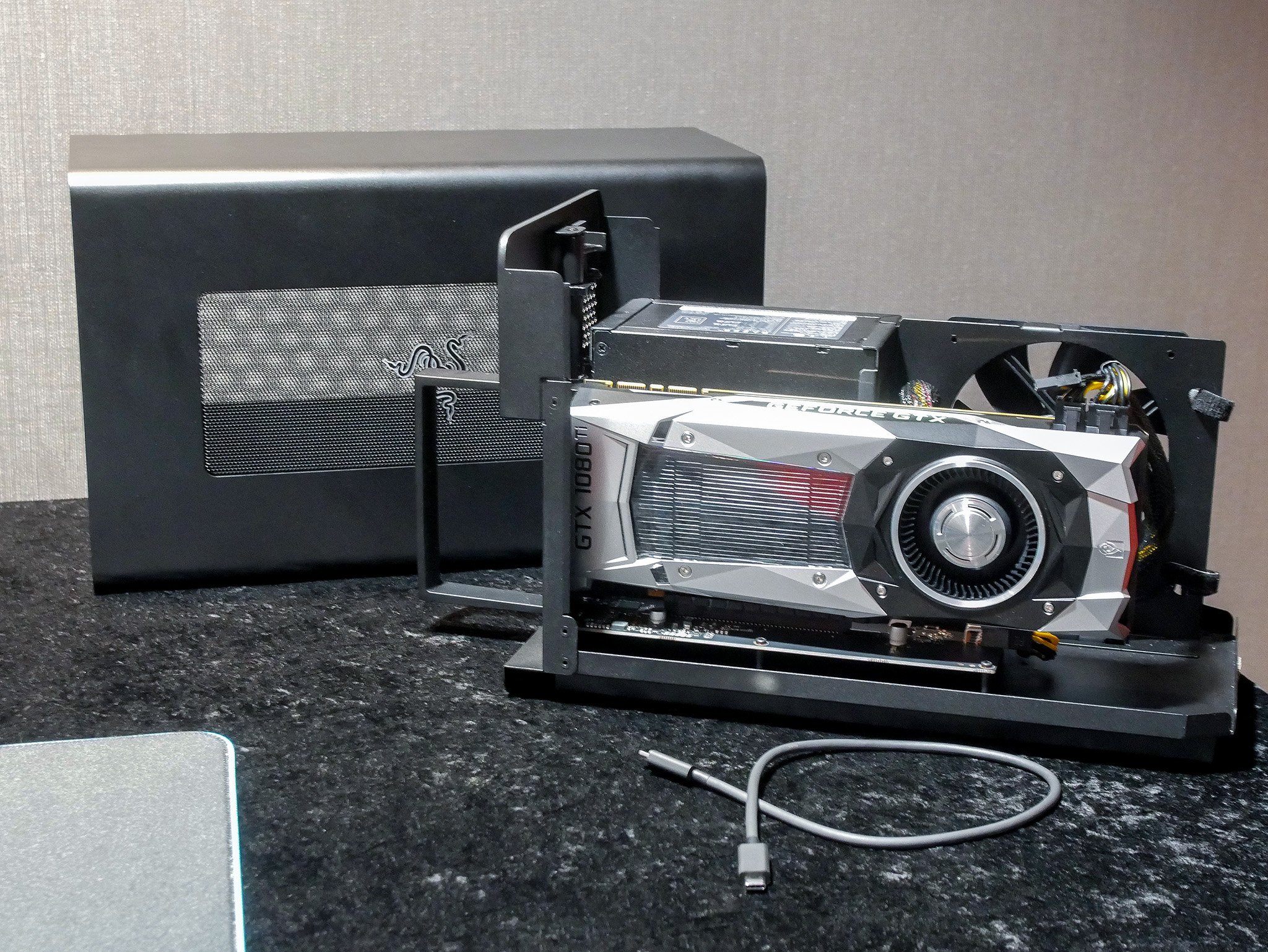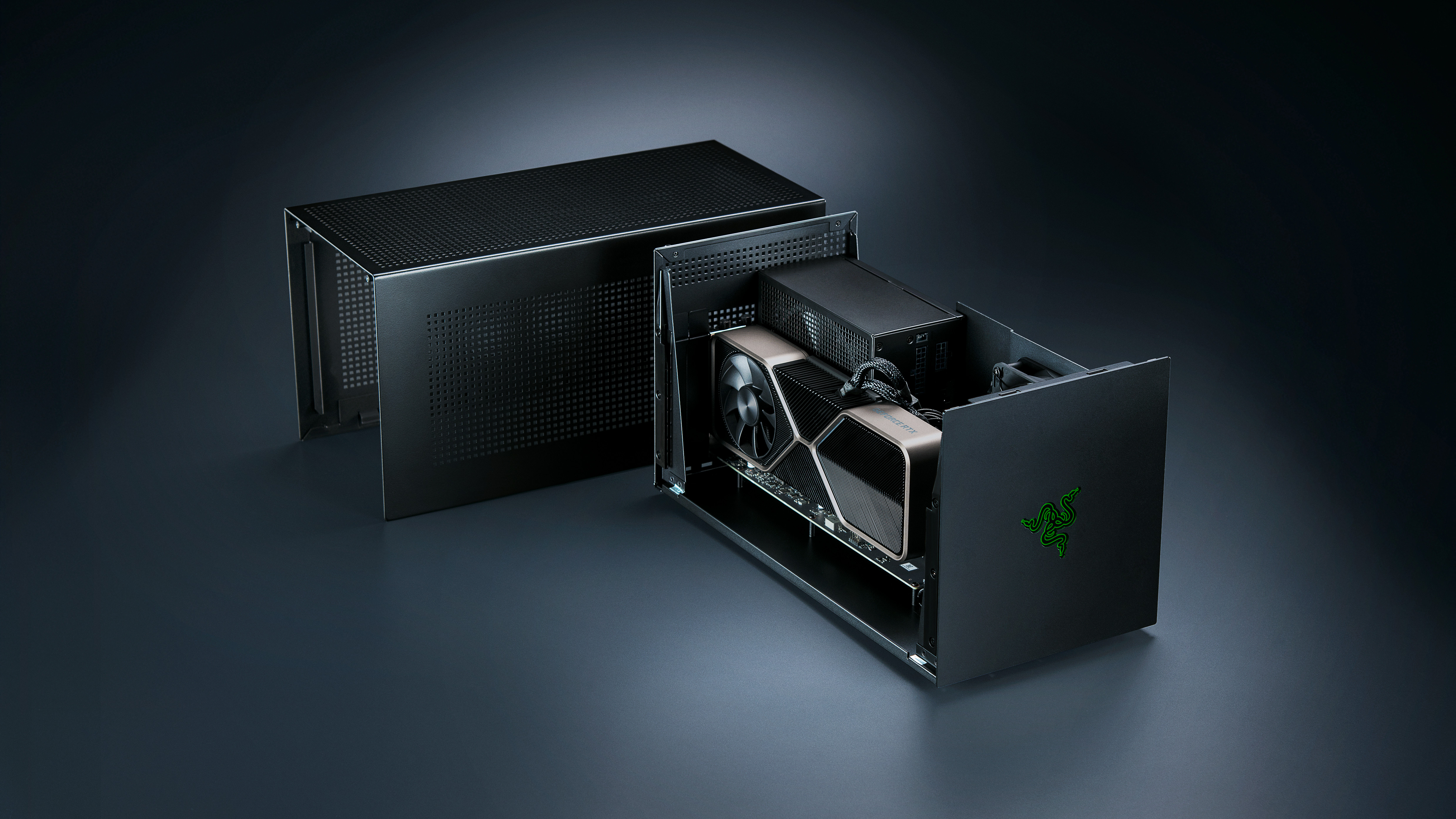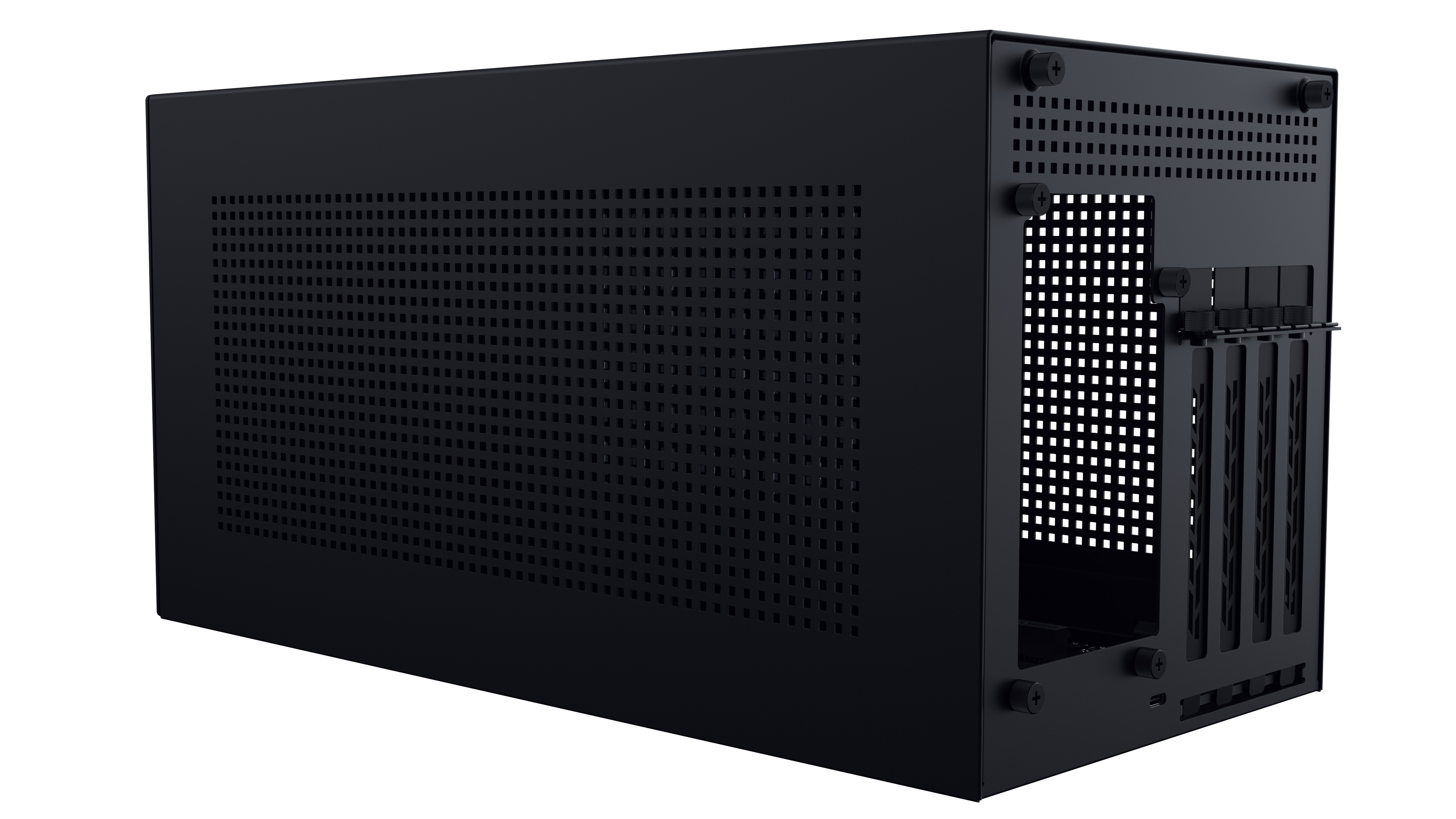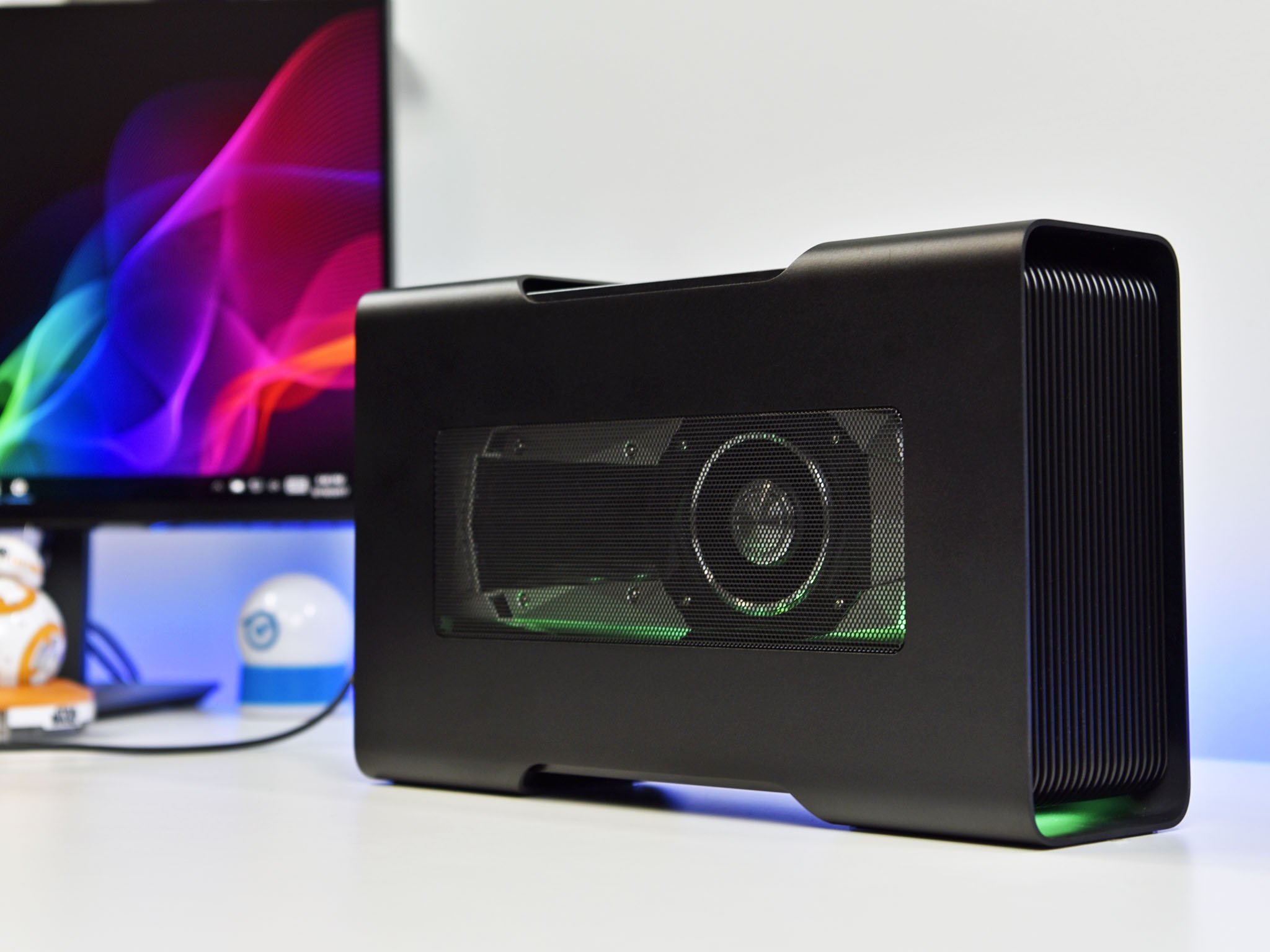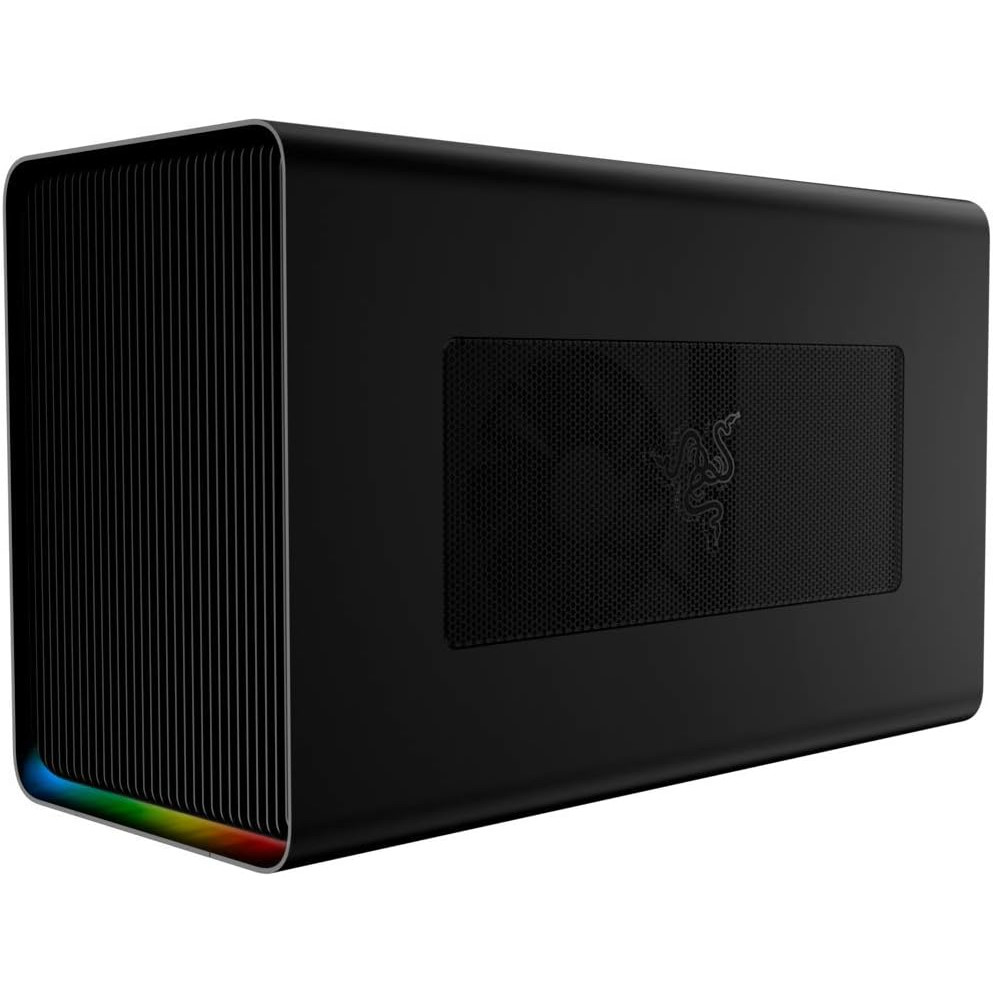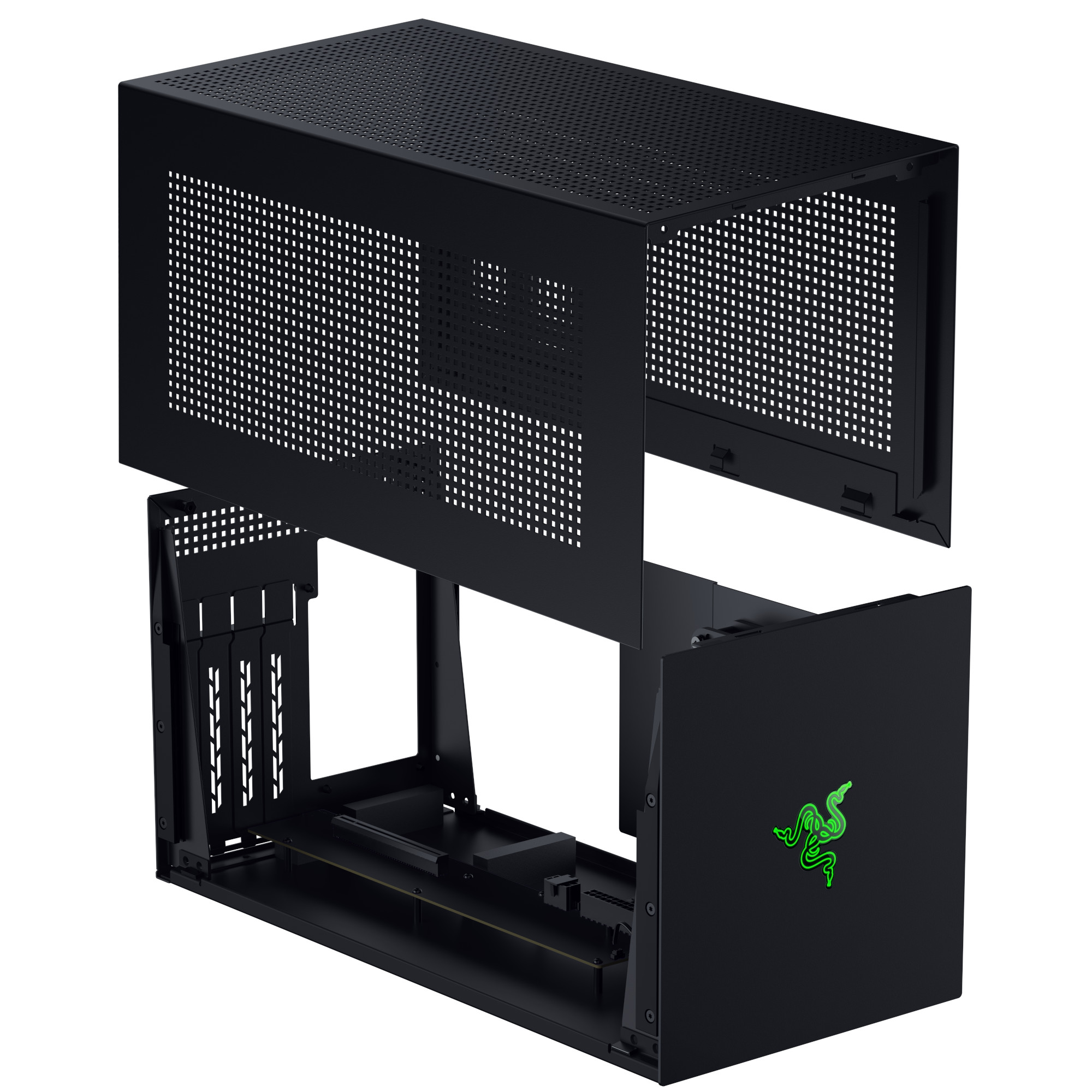
The Core X V2 is the latest eGPU from Razer, and it brings Thunderbolt 5 performance with PCIe 4.0 x4 support and room for the latest NVIDIA and AMD GPUs. It costs more than its predecessors and lacks some older features, but it's the logical choice in 2025.
Pros
- Thunderbolt 5 performance is far superior to Thunderbolt 3/4
- Supports 4-slot, full-length GPUs
- Boxier, more modern design
- Up to 140W of host charging power
- PCIe 4.0 x4 performance
Cons
- No additional USB or Ethernet ports
- No PSU included, which adds to the cost
- No Chroma lighting (yet)
- Costs more than its predecessor
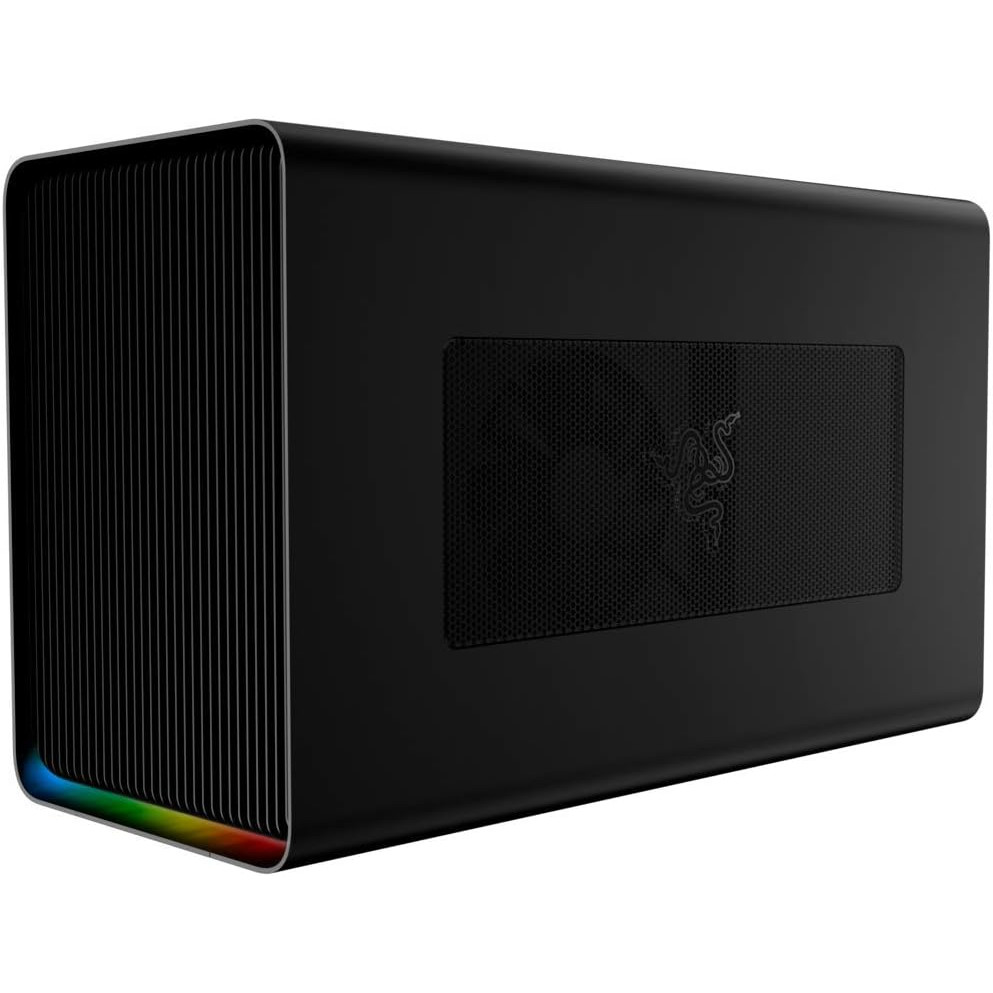
Razer's Core X and Core X Chroma V1 models are no longer available new, but there is a used market with several options. It'll do the trick for older GPUs and laptops with up to Thunderbolt 4, but I recommend future-proofing with the Core X V2.
Pros
- Was great in its time
- Available in standard and Chroma (RGB) versions
- PSU included to reduce cost
- Five USB-A and Gigabit Ethernet connections
Cons
- No longer available to buy new, used models are iffy
- Thunderbolt 3/PCIe 3 performance doesn't compare
- Tops out at 3-slot GPU support
Gaming laptops are a convenient way to take your favorite titles with you wherever you go. I love to play on a high-end gaming laptop, but they do come with some downsides.
Gaming laptops often cost more than standard laptops; they're usually heavier and thicker, and they often don't have the right aesthetic to fit into a professional environment.
What if you could take a regular laptop with a Thunderbolt port and connect a full-size desktop graphics card (GPU) with just one cable? That's where Razer's Core X hardware comes into play.
The original Razer Core X and Core X Chroma external GPUs (eGPU) have now received a massive upgrade in the form of the Core X V2, bringing Thunderbolt 5 performance to handle modern cards.
I'm here to shed some light on the upgrades (and downgrades) you can expect, as well as my thoughts on value and who should buy this type of hardware.
Razer Core X V2 vs. Core X V1: Specs and availability
Razer's Core X V1 has become difficult to find seven years after its 2018 launch date, and the Core X Chroma V1 — an updated version with 50W of extra power and RGB lighting — is in the same boat, six years after its launch.
While you can still find some models for sale on eBay, your mileage will vary in regard to condition and pricing. The cheapest price I spotted was about $76, but prices climb to $500 and beyond.
All the latest news, reviews, and guides for Windows and Xbox diehards.
The original model was available in Black and Mercury White color options, as well as with additional RGB lighting in the Chroma model.
Razer's updated Razer Core X V2 was officially announced on July 15, 2025, and it's expected to be "available soon" in a Black finish, according to Razer.
The Razer Core X V2 is set to debut with a $349.99 price tag. That's about $50 more than the Razer Core X V1's original MSRP.
Considering the new Core X V2 doesn't come with a built-in PSU like its predecessor, you'll want to add that cost to your total as well.
Here's a look at the specs that make up these two external GPUs from Razer.
| Header Cell - Column 0 | Razer Core X V2 | Razer Core X / Chroma V1 |
|---|---|---|
Host connection | Thunderbolt 5 | Thunderbolt 3 |
Expansion slot | PCIe 4.0 x4 | PCIe 3.0 |
PSU | ATX PSU (sold separately) | 650W (included), 700W (Chroma, included), 2x 2+6 power pins |
Compatible laptops | Thunderbolt 5, Thunderbolt 4, USB4 (required external graphics support) | Thunderbolt 3, Thunderbolt 4 |
GPU support | Up to 4-slot, full-length | Up to 3-slot, full-length |
Host power delivery | Up to 140W | Up to 100W |
Internal dimensions | 14.27 (L) x 7.28 (W) x 3.22 (H) inches (362.7mm x 185.1mm x 82mm) | 12.99 (L) x 2.24 (W) x 6.29 (H) inches (330mm x 57mm x 160mm) |
External dimensions | 16.59 (L) x 7.76 (W) x 8.51 (H) inches (421mm x 197mm x 216mm) | 14.72 (L) x 6.61 (W) x 9.06 (H) inches (374mm x 168mm x 230mm) |
Weight | 8.64 pounds (3.9kg) | 14.29 pounds (6.48kg) |
System requirements | Windows 11, Thunderbolt 5 or Thunderbolt 4 or USB4 | Windows 10 (or newer), Thunderbolt 3 or Thunderbolt 4 |
What are the major differences between the Razer Core X V1 and V2?
The biggest difference between the Razer Core X / Core X Chroma V1 and the newer Core X V2 is their means of connectivity.
Whereas the V1 model used Thunderbolt 3 (and later Thunderbolt 4), the Core X V2 uses Thunderbolt 5. Even compared to Thunderbolt 4, the latest Thunderbolt standard doubles the bandwidth.
That means you can expect transfer speeds up to 80Gb/s (or 120Gb/s with TB5's Bandwidth Boost enabled), more than what is required to appease the eGPU's PCIe 4.0 x4 GPU slot that tops out at 64Gb/s.
The Razer Core X V2 also now supports larger GPUs, which is a welcome change in a market rife with monster cards that barely fit into many desktop cases.
Razer says the Core X V2 can handle 4-slot cards at full length, whereas the V1 model topped out at 3-slot cards.
The new Razer Core X V2 weighs a lot less than its predecessor, but that's because it no longer ships with a built-in power supply unit (PSU).
The Core X V1 came with a 650W PSU included, and the Core X V1 Chroma upped that to 700W when it launched shortly after.
Rather than guessing which PSU would best suit your GPU of choice, Razer left the space open in the Core X V2, with support for any standard ATX PSUs.
I don't necessarily mind this change, but the Core X V2 already costs $50 more than its predecessor when it launched. Adding a PSU will bump that price up considerably, at least unless you have an extra unit sitting around idle.
Because the Core X V2 can now deliver up to 140W of power back to the host laptop via the USB-C cable, Razer recommends adding at least 230W of power to the PSU on top of the power that's required to run the graphics card.
In terms of overall design, the new Razer Core X V2 has a much boxier shape that I'd say looks a lot more mature than its predecessor. It does not, however, offer any extra ports aside from the USB-C/Thunderbolt connection.
The Razer Core X Chroma V1 had four USB-A 3.2 ports and a Gigabit Ethernet hookup, which came in super handy for accessories and wired internet on laptops lacking the ports. It's a shame these were removed in the V2 model.
Thunderbolt 5 does have superior daisy-chaining abilities, and for a truly ultimate setup, you could add Razer's new Thunderbolt 5 Dock Chroma I reviewed into the mix.
Aside from a Razer logo on the Core X V2, there is a serious lack of RGB lighting; I wouldn't be surprised to see Razer follow up with a Chroma V2 model just like it did with its predecessor eGPU. Hopefully, it'll also come with some additional ports.
As for compatibility with laptops and GPUs, Razer says the new Core X V2 will work with Thunderbolt 5, Thunderbolt 4, and USB4 laptops and some gaming handhelds.
On the GPU side, NVIDIA and AMD cards are compatible. Razer has a GPU compatibility chart you can check to ensure your hardware will run properly, but it looks like basically everything from the RTX 5090 back to GTX 10-series cards will work.
For AMD, Razer lists Radeon RX 9000, RX 7000, RX 6000, and RX 5000 cards as compatible with the Core X V2.
The older Razer Core X V1 (Chroma) handles a wide range of older NVIDIA and AMD cards, up to RTX 30-series and Radeon RX 5000 series. Because the eGPU has its own PSU with 2x 2+6 power connectors, you need to stay in that arena in terms of GPU power.
Razer's Core X V2 is the logical choice in 2025
Considering the Razer Core X V1 and its Chroma companion are only available on secondhand markets, and considering how much of a performance improvement the Core X V2 brings with Thunderbolt 5, there's only one logical choice in 2025 for most people.
Sure, the Core X V1 will do a decent job if you're using an older NVIDIA or AMD GPU with a Thunderbolt 3/4 laptop, but I strongly recommend setting yourself up much better for the future with the new Core X V2 model.
It does, unfortunately, cost more than its predecessor when looking at MSRP, while lacking a PSU and extra outputs found in the V1 Chroma model.
But its Thunderbolt 5 performance, support for modern GPUs, and additional charging power are certainly perks that modernize the eGPU.
Razer should be giving its Razer Core X V2 the green light to buy for $350 in the near future. At the time of writing, you can sign up for availability notifications at the official Razer site.
And if you do want to take your chances on a used Razer Core X V1, do check out eBay for listings.

Cale Hunt brings to Windows Central more than nine years of experience writing about laptops, PCs, accessories, games, and beyond. If it runs Windows or in some way complements the hardware, there’s a good chance he knows about it, has written about it, or is already busy testing it.
You must confirm your public display name before commenting
Please logout and then login again, you will then be prompted to enter your display name.
